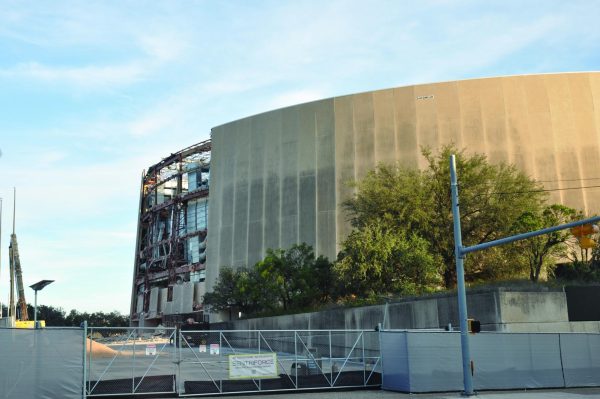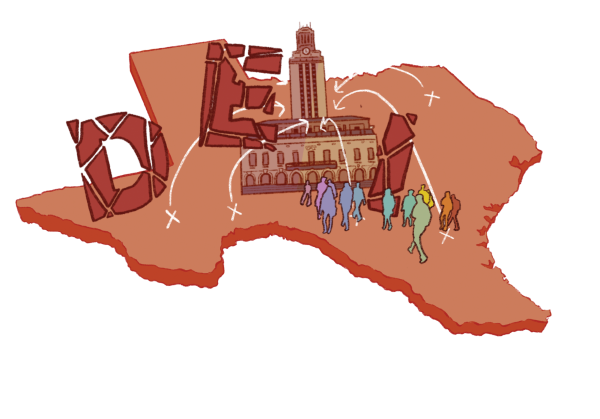One Campus, Two Schools
January 15, 2020
Despite the fact that LASA and LBJ will continue to share a campus in the 2020-2021 school year, Austin Independent School District (AISD) and the University Interscholastic League (UIL) officials have decided that LASA and LBJ will split for UIL purposes and will no longer participate in UIL athletic and academic competitions as one school. However, the schools will continue to compete as one in fine arts competitions like band, choir, dance and orchestra.
LASA and LBJ have shared a campus since 2007, but the Science Academy and LBJ have coexisted on the same campus since 1985. Ever since LASA’s creation in 2007, the two schools have been recognized as one under UIL classification and compete together as the LBJ Jaguars in athletics, fine arts and academic competitions.
Due to the passage of the 2017 AISD Bond Program, Austin public schools will receive over $1 billion to modernize campus facilities. LASA was awarded $10,380,000 and is on track to move to the East Side Memorial Early College High School campus in the fall of 2021. LASA Principal Stacia Crescenzi said that district and UIL officials decided that the UIL split was necessary in anticipation of LASA’s move to a separate campus.
“We always knew we would separate the teams when we got our own school,” Crescenzi said. “But as long as we were going to be on the same campus, there didn’t seem to be a need to [have separate teams]. Right now, LASA doesn’t exist for UIL purposes, it’s only LBJ.”
LASA and LBJ administrators began conversations about how the schools would be classified with UIL earlier this semester. Other options considered included competing with LBJ for one year after LASA moved, delaying the LASA move for a year, or sending in split numbers to UIL Despite these alternatives, Crescenzi said that the ultimate separation of the schools’ teams was a natural consequence of the bond.
“Right now, there’s nothing to suggest that after next year we aren’t moving,” Crescenzi said. “Brand new schools always get realigned in their first year of existence.”
UIL policy states that every two years, schools are realigned according to the official number of students enrolled on the last Friday in October. These numbers dictate which level the school will play at for the next two years. However, LASA is scheduled to move campuses in the middle of this biennium, meaning that LBJ would have to compete at a level based on the student population of the combined schools, even after LASA moved.
“We have 1,282 students,” Crescenzi said. “[LBJ has] 850. So it’s a big difference. Imagine we’re playing 6A ball or 5A large school ball and then [LASA] leaves. Now with 850 kids, which is a 4A number, [LBJ doesn’t] get realigned because they exist already. That is UIL rules. You will not get realigned in the middle of an alignment year if you already exist. So now you have LBJ playing athletics with numbers that are 4A at a large 5A or small 6A level. It’s just not safe.”
According to Crescenzi, safety considerations played a large role in the decision to split the two teams. If LBJ and LASA did not split UIL classification, LBJ would continue to play against schools with a greater student population, meaning that they have more students to fill an athletic roster.
“Part of what makes football safer is that you usually have kids that play offense, different kids that play defense, and different kids that play special positions,” Crescenzi said. “When you don’t have as big of a pool of kids, so your school is smaller, more kids play multiple roles. By the time you hit the second half, particularly the end of the third quarter, beginning of the fourth quarter, they’re exhausted because they’re constantly out on the field. They don’t ever have the recuperation time, so the chances of that kid getting hurt are greater.”
In early Dec., UIL announced that LASA will compete as a 5A Division II school team and LBJ will compete as a 4A Division I school. LASA has decided to initially play in a football league outside of UIL to give the team time to build.
“All the private and charter schools have football teams and they don’t play UIL, they play in the private school league,” Crescenzi said. “My goal is to play in that league for two years. The teams are smaller, but they’re just as competitive and they bring kids out, they have student sections, they have a band, they have cheerleaders, all of that exits. So in terms of the Friday night lights kind of events, it’s equal.”
Initially, LASA and LBJ’s athletic, academic and fine arts programs were all going to be split between the schools. In response, members from the community suggested that the two schools should continue to compete together as one school in the fine arts because there is no safety issue. After LASA’s move, LBJ might compete with a smaller orchestra or band, but there is no threat to an individual’s safety as there might be in a sport such as football. Campus Advisory Council (CAC) co-chair Melanie Plowman said that it was these concerns raised by the community that caused the district to change its policy on the split.
“I think concerns were aired with the initial announcement that we were splitting everything,” Plowman said. “That was the prompt for the district to do it in phases and to seek special permission from UIL to split the arts programs in the middle of the two-year alignment period.”
After the UIL split, LBJ will continue to play as the jaguars and will keep the school colors of purple and white. As a newly independent UIL school, LASA will need to establish its own mascot and colors. The class of 2022 Student Council (StuCo) coordinated with LASA administration and AISD to create the most efficient procedure for polling the student body and choosing a new mascot and colors. According to the class of 2022 president and sophomore Sally Edwards, StuCo has been proactive in preparing for LASA’s move.
“We have been discussing this since early last year and really started to bring it into effect early this year,” Edwards said. “There are two parts: the nomination and the voting. We finished the nomination process and we don’t know when we’ll begin the voting process.”
StuCo members met with Dr. Craig Shapiro, Associate Superintendent for High Schools for AISD, to verify their system. Edwards said the group was already coming up with methods for selection, but the news of the UIL split expedited the process.
“After our initial meeting with Dr. Shapiro to verify the whole process, Ms. Crescenzi came to us and told us they were doing the split next year,” Edwards said. “That sped it up. It was a surprise, but we’ve been able to work our way around it. There’s enough time to do everything correctly but still get everything done.”
Edwards said that the transition will not be easy for either school. She believes that competing together is a large part of what makes the schools feel like a community.
“I think obviously there’s pros and cons to this decision,” Edwards said. “It’s going to be weird to not be able to connect with the LBJ community and campus in the same way, but I think it will be kind of exciting to see what LASA does, especially with a lot of the athletics. I think it will be something that kind of brings the LASA community together, so I’m excited to see what happens.”
In response to community concerns and to ease the transition process, Shapiro created a UIL workgroup with the principals, the CAC co-chairs for both schools, the district director for athletics and the director of fine arts. The workgroup will also eventually include a parent and a staff member from each school. Plowman, a member of the group, said that their main objective is to advise the schools on how to split equitably and hold public meetings to hear from both communities.
“The idea of the group is to have an actual mechanism for the two schools to be talking and working through the details and get involved,” Plowman said. “We can get input from the district-level arts and athletics people as well as Dr. Shapiro because he is familiar with all of the high schools and the budgets and all of that kind of stuff that would come up.”
Additionally, they will assist booster clubs in forming and dividing current funds for different organizations. Since all sports will now have two teams instead of just one, booster clubs will have to raise money to support new programs.
“The existing booster clubs seem ready and willing to teach others how they operate and to share funds if needed,” Plowman said. “I think we just need to establish those connections and gather information. We will ask people to come and share information with us when we are dealing with an issue that is relevant to them.”
Although the decision to split has received mixed reactions from the LASA and LBJ communities, the sophomore class vice-president Erick Rodriguez said that it’s a complicated matter with no simple solution. He believes that the situation is being handled the best it can be.
“I think it’s a difficult process, and we should be lenient when judging it very harshly,” Rodriguez said. “We should put ourselves in the shoes of someone who has to run down the process and get it going, it’s really difficult.”









